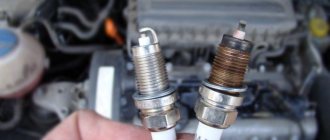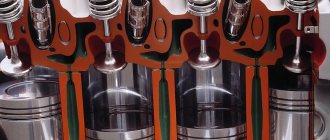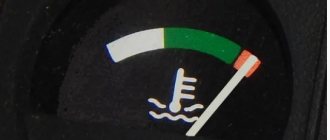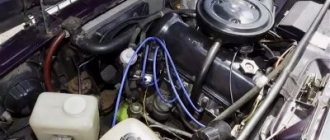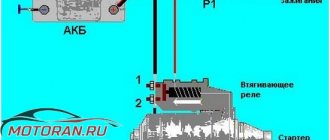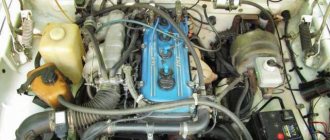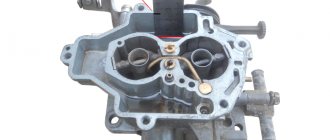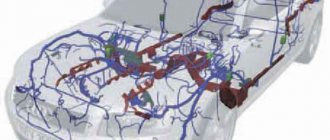Reasons why the cylinder does not work
What causes a cylinder to stop functioning? What does the phrase “cylinder not working” mean? It is known that in the internal combustion engine of a car there are cylinders where combustion of the combustible composition takes place. In this process, work is done when gases expanding during combustion push the piston down, turning the crankshaft.
If all 4 cylinders are operational, then the rotation of the car engine will be smooth, which can be immediately felt on the tachometer device, and this can be easily audible. And if a flammable composition does not ignite in a particular cylinder or work is not done to lower the piston, this will indicate that the engine is tripping. In this situation, the economizer arrow will begin to twitch, and the engine speed will lose stability.
What to do and what to pay attention to
In order to determine why the engine in a VAZ 2114 is misfiring, you must follow the recommendations of professionals. First of all, you need to determine which cylinder is out of order, for this you need to:
- open the hood with the engine running;
- remember the sound and nature of the operation of the power plant;
- remove the high-voltage wires from the spark plugs one by one, if the sound and rhythm of operation changes, then continue further, as soon as it is discovered that when the spark plug is de-energized, the nature of the sound does not change, which means the faulty cylinder has been identified.
Next, you need to unscrew the spark plug and determine its condition and performance.
The next step is to determine the condition of the removed spark plug. If the electrode is intact and clean, and there is a large amount of soot on the head, then with a high degree of probability it can be determined that dust has entered the combustion chamber of the cylinder, therefore the fault must be looked for in the air supply system through the air filter.
If the entire head, along with the electrode, is covered in smoke, and it is severely burnt out, it means that a lean mixture was supplied and detonation combustion occurred with ignition advance. When the head is also completely covered with smoke and the electrode is in good condition, this means that a rich mixture was supplied and there was a delay in the ignition supply.
Ignition coil module VAZ 2109
Assessing the condition of the spark plug gives direction in finding the true cause of cylinder failure. However, you should also check the performance of the candle itself. There is a proven method for this - “by spark”. If a spark breaks through, even if weak due to carbon deposits, then you must definitely look further. But if there is no spark at all, then you should replace the spark plug with a new one and check it. If there is a good spark, you can try to start the car and monitor the dynamics of changes.
If the car has a fairly high mileage, then trying to find the reason why the engine is shaking, you must do the following:
- change the spark plug;
- change the set of high-voltage wires; during prolonged operation under conditions of high temperatures and voltages, microcracks appear on the shell, leading to breakdowns and failure; experienced auto electricians recommend periodically changing this set for prevention;
- measure the compression in the idle cylinder; if it is broken, then perhaps the rings are stuck or the valves are burnt out;
- adjust the valves, this procedure should be carried out for prevention every 15 - 20 thousand kilometers;
- determine the performance of the ignition coil, this is a fairly common failure, the best solution is to replace the old one with a new one;
- change the air filter;
- Check that the timing belt is installed correctly.
All the specified procedures have been completed, but the engine still “troubles”. We need to move on:
- Conduct diagnostics of the electronic control unit and replace if necessary.
- Check the fuel supply system, down to the injectors.
- Determine the performance of the oxygen sensor, if it is faulty or produces deteriorated indicators - repair or replace.
- The failure of the crankshaft position sensor is determined by the computer, and an error should be generated indicating a breakdown. If this happens, replace it.
Reason No. 1 – no spark is supplied to the cylinder:
- Irregularities in the spark plug. It may make its way onto the body or its gap may be set incorrectly. To control the correct operation of the spark plug, you need to unscrew it and lean it against any metal part. After that, by turning the starter, we determine by eye whether sparks appear on the spark plug. It is taken with pliers; Rubber gloves should be worn on hands. Anyone who has been hit by a 20 kV shock will fully agree that safety is absolutely necessary. Remember that although there is a spark jumping on an unscrewed spark plug, this is not a 100% indicator of its correct operation. After all, the cylinder has a completely different environment.
- Wire breakdown. If it breaks through, the spark will become extremely insignificant or disappear completely. I mentioned safety due to the fact that in my case, the factor that caused the carburetor in the VAZ 2109 to malfunction and the engine to not pull was precisely the breakdown. I began to move the wire with the engine running and took it with my unprotected hands. When receiving an electric shock, a person is unable to release the wire on his own. It was lucky that an acquaintance was nearby. Be carefull!
- There is a problem with the car's ignition distributor. For example, a contact burned out or mechanical wear occurred. This can lead to the fact that a spark from the distributor stops going to a specific cylinder.
- Hall Sensor. If it is not fully operational, it is capable of transmitting pulses from the drum on the car distributor shaft and not sending them to the switching device. That is, sparks will be missed.
The engine stalls at idle: common causes and quick diagnosis
It is quite obvious that with such a malfunction it becomes difficult to operate the vehicle, since you have to constantly increase the speed to maintain normal operation of the internal combustion engine. As a result, fuel consumption increases noticeably, cold starting of the engine can also be very difficult, etc.
At the very beginning, you need to determine which cylinder is not working. To do this, start the internal combustion engine, and then disconnect the high-voltage wires from the spark plugs one by one. If after disconnecting the power the engine operation changes, this means that the cylinder is working. Turning off the power from the non-working cylinder, on the contrary, will not lead to a change in the sound and nature of the operation of the power unit.
In some cases, replacing the spark plug or cleaning it allows you to normalize engine operation and get rid of “triple”. It should be remembered that although spark plugs can be designed for 30-80 or even 100 thousand km. mileage, when driving on domestic fuel, it is often necessary to change these elements already at 20-25 thousand.
It is also important to consider that when checking high-voltage equipment, you need to follow safety precautions. If you have no experience, then it is advisable to put a wooden block, a rubber mat, etc. under your feet.
Also, when disconnecting the wires from the spark plug, do not hold onto the cap. You need to grab a high-voltage wire. In this case, you should try not to touch the engine and car body.
At the same time, it should be understood that armored wires can also be damaged and penetrated. By the way, if the spark “goes somewhere”, in the dark it is enough to look under the hood to detect a breakdown.
Please note that when a diesel engine is running, to check it is necessary to alternately turn off the supply of diesel fuel to the injectors. To do this, unscrew the fittings on the high-pressure lines.
Now let’s imagine that the required cylinder has been found, the spark plug gives a spark, the armored wire is in perfect order, and the engine still runs rough. In this case, you need to unscrew the spark plug again and inspect the tip, determining whether it is wet or dry. As a rule, this will indicate problems with mixture formation.
If the spark plug is wet, then the air/fuel mixture may be too rich. A dry spark plug indicates that the mixture is too lean. In both the first and second cases, the cylinder will not work on such a mixture, even if the ignition system is working. The cause may be contamination or damage to the injectors, as well as the leakage of excess air.
As part of the diagnostics, you can perform a quick check of the injectors by disconnecting the power plugs from them. If when you turn off the power from any injector the engine operation does not change, then this is a faulty element. To confirm or refute this, swap this injector with the one in the adjacent cylinder. If the cylinder operates normally, then the problem is not the injector.
Finally, it should be remembered that an injection engine also fails in many cases due to damage or failure of coils, commutators, ECM sensors, incorrectly set timing marks, etc. In some cases there may be no spark, in others there is a spark and everything is fine with the fuel supply, but tripping is still present.
In such situations, it will be extremely difficult to solve the problem yourself, especially on the road. It is better to immediately go for computer diagnostics. For example, a failure or incorrect signal from the mass air flow sensor (mass air flow sensor) is often the reason why the engine runs unevenly and idles.
Reason No. 3 - compression does not occur in the cylinder:
- The piston burned out. If this happens, then during the compression stroke no pressure is produced in the cylinder, and the flammable composition flies into the crankcase. Through the ventilation system, gases are sent for afterburning into the car's air filter.
- Burnt out compression rings. Identical, the pressure disappears through broken rings.
- The intake and exhaust valves are burnt out.
- Incorrect valve adjustment.
- Hardening of valve stem seals. Such a cap does not allow the valves to completely close the cylinder intake and exhaust ports.
- The cylinder head gasket had blown and pressure began to enter the cooling system. Usually in this situation there is an explosion of a barrel of antifreeze or the presence of antifreeze in the oil.
If you are unable to identify a non-functioning cylinder, follow these steps. Wear rubber gloves. Using the choke, set the idle speed of the car engine to 1500 rpm. And unplug the wire from all cylinders one by one. Watch how the carburetor of the VAZ 2109 troits when cold. Did it start shaking, choking, stalling? Therefore, the cylinder is normal and operational. Reconnect this wire and disconnect the other cylinder. If the functioning of the motor does not change when the wire is thrown away, then the cylinder is not working.
Finally, it is possible to determine whether the reason lay in the lack of sparking or in something else. Let's unscrew the spark plug, hold it in pliers, bring it to the ground, and turn the electric starter. If a strong spark appears on the spark plug, then look for the answer among reasons 2 and 3.
It is important to understand that if it is tripping due to air leaks, then removing the wires will not help, and it is impossible to identify the inoperative cylinder. The cause of the problem in such a situation will be a depleted combustible composition.
If you still have questions regarding the question of why the VAZ 2109 engine with a carburetor fails, I recommend watching this video:
Why does the engine of a VAZ 2109 car troit?
The reason that the engine on the VAZ 2109 is misfiring is the uneven combustion of fuel in a single cylinder. The reasons for this may be:
- The ignition timing is set incorrectly.
- There has been a malfunction in the vacuum corrector system for ignition distribution or in the carburetor accelerator pump.
- The spark plugs have become unusable.
- A high-voltage wire has broken.
- Capacitor failure.
- There is a leak in the intake manifold or carburetor.
- Burnt pistons or valves.
- The piston rings are broken.
- Valves incorrectly adjusted.
- The gasket in the cylinder head has broken.
- The valve stem seals are worn, hardened or destroyed.
- Use of very low quality fuel.
- The carburetor is not adjusted correctly.
- The distributor shaft and the rotary plate bearing are worn out.
- The membrane of the vacuum ignition accelerator has lost its tightness.
- There are other reasons why the engine of the VAZ 2109 troits.
How to eliminate some causes of engine tripping
If during the initial period of movement of a VAZ 21093 car the engine stalls, most likely the accelerator pump or the vacuum corrector of the ignition distributor has broken down. In this case, diagnostics of components is carried out and, if necessary, repair or replacement of elements. To work you will need:
- Wrenches for “10” and “8”.
- Slotted and Phillips screwdrivers.
- Clean rags.
- Copper wire without an insulating layer with a diameter of up to 0.3 mm.
- Compressor.
- Liquid type WD40.
Order of operations:
- The air filter cover is removed. To do this, unscrew the nut with a “10” key and unfasten the spring clips.
- The air filter is pulled out. Use a key “8” to unscrew the four nuts, use a screwdriver to loosen the clamp on the crankcase ventilation hose at the place where it is connected to the valve cover and remove the housing from the air filter.
- The hose is disconnected from the vacuum corrector drive for ignition distribution. The tightness of the assembly is checked by creating a vacuum of air through the mouth.
Checking the tightness of the vacuum corrector drive
- If air passes through, the unit needs to be replaced. Otherwise you need to:
- Look inside the carburetor. The air damper must be completely open. When you press the throttle control lever, a stream of fuel should appear from the two nozzle tubes of the accelerator pump. They should be level, directed into the space between the opening damper and the diffuser wall. The photo shows the holes for the fuel outlet.
Carburetor with cover removed
- If there is no fuel outlet, you need to remove the hoses supplying fuel to the carburetor and drain it.
- The torso is detached to control the air damper.
- The wire located on the idle air solenoid valve is removed.
- Unscrew the screws holding the top carburetor cover.
- The lid is removed and placed with the floats facing up.
- Carefully pry off the atomizer with a screwdriver and pull it out of the socket.
- Use a thin copper wire to clean the atomizer nozzle holes.
- The atomizer is blown with air in the opposite direction of the direction of fuel movement.
- The element is installed in place.
- Without installing the assembly cover, you need to press the drive lever for the throttle valve. Fuel streams should appear from the two nozzle tubes of the acceleration pump.
- If they are not there, you need to check the absence of play in the drive and the accelerator pump drive lever and its ease of movement. To facilitate work, the parts are lubricated with WD40 type fluid. Parts that have become unusable are replaced with new ones.
- The operation of the accelerator pump is re-checked.
- The carburetor is assembled in reverse order.
- If there are no streams again, you need to contact a car service.
The reason that the engine of a VAZ 21093 car is experiencing trouble may be the abnormal condition of the spark plugs. Their price is insignificant and it is better to replace burnt out spark plugs immediately.
The candle is in abnormal condition
This video will help you learn how to change spark plugs yourself. So:
- The operating instructions supplied with the car indicate that the spark plugs should be replaced regularly. Even the presence of a spark on a twisted element at atmospheric pressure does not mean that it is fully operational. Its ignition occurs under more difficult conditions.
- It is not very common for piston rings to get stuck or break. You can check this by measuring the compression. If it is low, then a cylinder head malfunction can be ruled out in a simple way: a little oil is poured into the cylinder and an increase in compression indicates a breakdown in the piston system.
Why does a cold VAZ 2109 carburetor troit?
- Registration
- Entrance
- To the beginning of the forum
- Forum Rules
- Old design
- FAQ
- Search
- Users
We have a VAZ 21093 91 onwards. , carburetor—real mileage is unknown, but the speedometer shows 91,000 km. Malfunctions of the following nature: 1) When starting in the morning, the engine runs steadily for 10-15 seconds, after which it begins to fluctuate - obvious misfires are heard in the muffler - the engine jerks. As it warms up, the gaps become smaller and smaller - when it warms up to 50 degrees, the machine begins to work smoothly, but rare and small gaps are still sometimes observed. 2) The engine, it seems to me, does not have sufficient throttle response (I compare the sensations with the previous car 2105). 3) Slightly increased gasoline consumption in the city is 11-12 liters, and on the highway it is normal 7-8 liters.
What was repaired: 1) Replacing valve stem seals (due to high oil consumption) 2) Adjusting valves (before adjustment, the engine was quieter) 3) Repairing and adjusting the carburetor (the thread for the idle valve was broken, the power mode diaphragm was torn) 4) Rebuilt ignition distributor (weights did not return to normal state under the action of springs) 5) Spark plugs, wires, distributor cover, slider were replaced. 6) Replaced vacuum brake booster
All this led to improvements in engine performance, but the faults listed at the beginning remained.
Additional information: 1) The spark plugs look like they are running on a lean mixture 2) The quality screw for normal engine operation is unscrewed by 7 turns 3) when the engine revs and accelerates a little, then when the speed returns to nominal the engine (as it seems to me) runs 1-2 seconds smoother and then starts swarming again
I was a little scared that the malfunctions indicate burnout of the valves. I myself am inclined to think that it is sucking air somewhere, but I can’t find where. I didn’t measure the compression (or rather, the first time I measured the readings 12-12-12-8.8, the second time with a faulty compression gauge - it showed 8 in all cylinders (the ones who gave them said that the compression gauge was faulty))
I was a little scared that the malfunctions indicate burnout of the valves. I myself am inclined to think that it is sucking air somewhere, but I can’t find where. I didn’t measure the compression (or rather, the first time I measured the readings 12-12-12-8.8, the second time with a faulty compression gauge - it showed 8 in all cylinders (the ones who gave them said that the compression gauge was faulty))
Try the compression again and somewhere else. If everything is the same, then it’s possible that something went wrong when adjusting the valves, or perhaps it’s close to a capital or semi-capital problem. I recently ground the valves, and sometimes it also breaks. There is no time to do everything. Unpleasant.
Paper brought to the muffler when skipped simply sticks to the hole. Anyone have any thoughts.
Look at the marks, camshaft, valves, there doesn’t seem to be anything else, although anything can happen.
Source
Checking the engine at idle
Faulty VAZ 2109 ECU (burnt-out transistor unit) If you notice that the VAZ-2109 engine starts to oscillate at idle, then you need to check the following systems:
- Fuel supply system.
- Ignition system.
- Valve system.
In the first case, if the faults are in the fuel supply system, then the first step is to flush the fuel system, and then clean the injectors using ultrasound.
The second case involves problems with the ignition system. Therefore, perform the following actions:
- change spark plugs;
- check the functionality of the ignition coil;
- update the set of high-voltage wires.
In the third case, the valves are closely dealt with, that is, they should be adjusted so that they perform their functions properly. If this cannot be done, the old valves are simply replaced with new ones.
